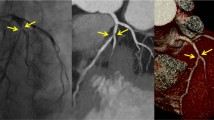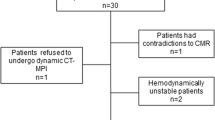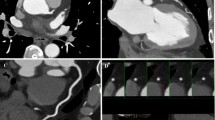Abstract
To assess the diagnostic accuracy of prospective ECG-triggering 64-slice multidetector computed tomography (MDCT) coronary angiography for evaluation of coronary artery disease (CAD). Forty-two patients (31 males, 11 females, mean age 64 years) underwent cardiac CT and invasive coronary angiography (ICA). Patients with a heart rate of <65 beats/min with stable heart rhythm were included in the study sample. We used a prospective ECG-triggering protocol. Luminal narrowing over 50% was considered to be significant according to a modified 17-segment AHA model, using invasive coronary angiography (ICA) as the standard of reference. The mean radiation dose was 3.5 mSv ± 0.3 (range, 3.3–4.2 mSv), and 542 of 549 segments (98.7%) in the 42 patients were diagnostic. In contrast, 119 of 542 segments (22%) were diagnosed as significant by ICA. The sensitivity, specificity, accuracy, PPV and NPV were 95.0, 96.2, 96, 85.8 and 98.8%, respectively. False positive results were affected by densely calcified plaques, whereas false negatives were caused by motion artifact with poor vessel attenuation at the distal segments or near the bifurcation area of the coronary arteries. Prospective ECG-triggering MDCT is a useful method for evaluating CAD in patients with a lower heart rate with low radiation dose.



Similar content being viewed by others
References
Klass O, Jeltsch M, Feuerlein S, Brunner H, Nagel HD, Walker MJ et al (2009) Prospectively gated axial CT coronary angiography: preliminary experiences with a novel low-dose technique. Eur Radiol 19:829–836
Stolzmann P, Leschka S, Scheffel H, Krauss T, Desbiolles L, Plass A et al (2008) Dual-source CT in step-and-shoot mode: noninvasive coronary angiography with low radiation dose. Radiology 249:71–80
Raff GL, Gallagher MJ, O’Neill WW, Goldstein JA (2005) Diagnostic accuracy of noninvasive coronary angiography using 64-slice spiral computed tomography. J Am Coll Cardiol 46:552–557
Mollet NR, Cademartiri F, van Mieghem CA, Runza G, McFadden EP, Baks T et al (2005) High-resolution spiral computed tomography coronary angiography in patients referred for diagnostic conventional coronary angiography. Circulation 112:2318–2323
Scheffel H, Alkadhi H, Plass A, Vachenauer R, Desbiolles L, Gaemperli O et al (2006) Accuracy of dual-source CT coronary angiography: first experience in a high pre-test probability population without heart rate control. Eur Raidol 16:2739–2747
Ropers U, Ropers D, Pflederer T, Pflederer T, Anders K, Kuettner A et al (2007) Influence of heart rate on the diagnostic accuracy of dual-source computed tomography coronary angiography. J Am Coll Cardiol 50:2393–2398
Johnson TR, Nikolaou K, Busch S, Thorsten RC, Konstantin N, Stephanie B et al (2007) Diagnostic accuracy of dual-source computed tomography in the diagnosis of coronary artery disease. Invest Radiol 42:684–691
Hatem Alkadhi H, Hans Scheffel H, Desbiolles L, Gaemperli O, Paul Stolzmann P, Plass A et al (2008) Dual source computed tomography coronary angiography: influence of obesity, calcium load, and heart rate on diagnostic accuracy. Eur Heart J 29:766–776
Earls JP, Berman EL, Urban BA, Curry CA, Lane JL, Jennings RS et al (2008) Prospectively gated transverse coronary CT angiography versus retrospectively gated helical technique: improved image quality and reduced radiation dose. Radiology 246:742–753
Einstein AJ, Moser KW, Thompson RC, Cerqueira MD, Henzlova MJ (2007) Radiation dose to patients from cardiac diagnostic imaging. Circulation 116:1290–1305
Husmann L, Valenta I, Gaemperli O, Adda O, Treyer V, Wyss CA et al (2008) Feasibility of low-dose coronary CT angiography: first experience with prospective ECG-gating. Eur Heart J 29:191–197
Hirai N, Horiguchi J, Fujioka C, Kiguchi M, Yamamoto H, Matsuura N et al (2008) Prospective versus retrospective ECG-gated 64-detector coronary CT angiography: assessment of image quality, stenosis, and radiation dose. Radiology 248:424–430
Scheffel H, Alkadhi H, Leschka S, Plass A, Desbiolles L, Guber I et al (2008) Low-dose CT coronary angiography in the step-and-shoot mode: diagnostic performance. Heart 94:1132–1137
Stolzmann P, Leschka S, Scheffel H, Krauss T, Desbiolles L, Plass A et al (2008) Dual-source CT in step-and-shoot mode: noninvasive coronary angiography with low radiation dose. Radiology 249:71–80
Rybicki F, Otero H, Steinger M, Vorobiof G, Nallamshetty L, Mitsouras D et al (2008) Initial evaluation of coronary images from 320-detector row computed tomography. Int J Cardiovasc Imaging 24:535–546
Stolzmann P, Scheffel H, Leschka S, Plass A, Baumülker S, Marincek B et al (2008) Influence of calcifications on diagnostic accuracy of coronary CT angiography using prospective ECG triggering. Am J Roentgenol 191(6):1984–1989
Austen WG, Edwards JE, Frye RL, Gensini GG, Gott VL, Griffith LS et al (1975) A reporting system on patients evaluated for coronary artery disease. Report of the Ad Hoc committee for grading of coronary artery disease, council on cardiovascular surgery, American heart association. Circulation 51:5–40
Shuman WP, Branch KR, May JM, Mitsumori LM, Lockhart DW, Dubinsky TJ et al (2008) Prospective versus retrospective ECG gating for 64-detector CT of the coronary arteries: comparison of image quality and patient radiation dose. Radiology 248:431–437
Leber AW, Knez A, von Ziegler F, Becker A, Nikolaou K, Paul S et al (2005) Quantification of obstructive and nonobstructive coronary lesions by 64-slice computed tomography: a comparative study with quantitative coronary angiography and intravascular ultrasound. J Am Coll Cardiol 46:147–154
Trabold T, Buchgeister M, Kuttner A, Heuschmid M, Kopp AF, Schroder S et al (2003) Estimation of radiation exposure in 16-detector row computed tomography of the heart with retrospective ECG-gating. Rofo 175:1051–1055
Coles DR, Smail MA, Negus IS, Wilde P, Oberhoff M, Karsch KR et al (2006) Comparison of radiation doses from multislice computed tomography coronary angiography and conventional diagnostic angiography. J Am Coll Cardiol 47:1840–1845
Efstathopoulos EP, Kelekis NL, Pantos I, Brountzos E, Argentos S, Grebac J et al (2009) Reduction of the estimated radiation dose and associated patient risk with prospective ECG gated 256-slice CT coronary angiography. Phys Med Biol 54:5209–5222
Pugliese F, Mollet NR, Runza G, van Mieghem C, Meijboom WB, Malagutti P et al (2006) Diagnostic accuracy of non-invasive 64-slice CT coronary angiography in patients with stable angina pectoris. Eur Radiol 16:575–582
Hoffmann U, Moselewski F, Cury RC, Ferencik M, Jang IK, Diaz LJ et al (2004) Predictive value of 16-slice multidetector spiral computed tomography to detect significant obstructive coronary artery disease in patients at high risk for coronary artery disease: patient-versus segment-based analysis. Circulation 110:2638–2643
Kroft LJ, de Roos A, Geleijns J (2007) Artifacts in ECG-synchronized MDCT coronary angiography. Am J Roentgenol 189:581–591
Author information
Authors and Affiliations
Corresponding author
Rights and permissions
About this article
Cite this article
Hong, Y.J., Kim, S.J., Lee, S.M. et al. Low-dose coronary computed tomography angiography using prospective ECG-triggering compared to invasive coronary angiography. Int J Cardiovasc Imaging 27, 425–431 (2011). https://doi.org/10.1007/s10554-010-9674-4
Received:
Accepted:
Published:
Issue Date:
DOI: https://doi.org/10.1007/s10554-010-9674-4




